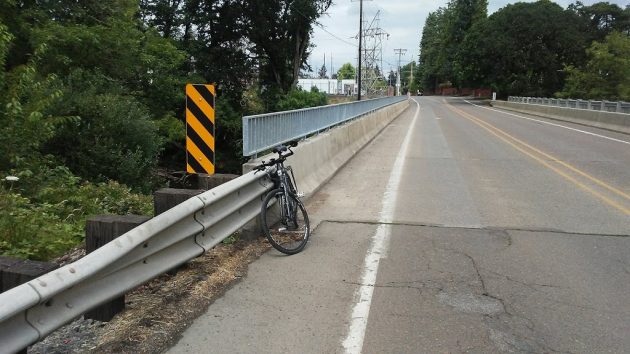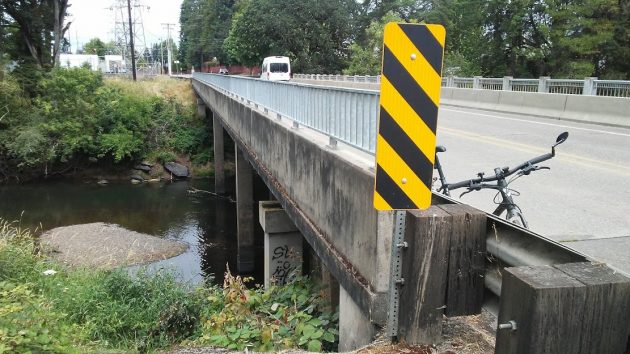
The addition of a metal railing was meant to meet OSHA height requirements for worker safety.
Crossing the Calapooia River on that Albany bridge above takes a couple of seconds and is nothing remarkable. But if you’re on a bike, you may notice something new.
What I noticed on July 10 was that a steel top had been added to the concrete barrier that lines the bridge’s downstream side. I wondered why.
The answer came in the form of a note from Linn County Roadmaster Darrin Lane, passed along by Commissioner Roger Nyquist: “The railing was removed from another bridge a few years ago because of a sight distance issue. Our bridge crew added it to this bridge because they frequently work in the vicinity of the railing during winter months and OSHA requires a safety rail higher than the existing concrete rail.”
So, another question: How high is that railing now? Next day, I packed a tape measure and checked. It’s a hair above 54 inches. The concrete barrier alone measures about 32 inches, and the metal adds 22.
Next question: What exactly is required for worker safety? In 2016, Oregon OSHA published a pamphlet,”Fall Protection for Construction Activities.” There it says, “The top rail of a guard rail must be 42 inches (plus or minues 3 inches) above the walking/working surface.” It must also, by the way, withstand a force of 200 pounds.
Various other online sources also mention 42 inches as the minimum height for pedestrian railings on bridges.
Which brought up one final question: What exactly should we call this bridge? The city of Albany’s official street map says the bridge is on Riverside Drive. But Google Maps says Queen Avenue, and the post office shows the addresses of properties adjacent to the bridge on the city side as being on Queen.
The Calapooia marks the city limits. So maybe half the span is the Queen Avenue Bridge, and the other half the Riverside Drive Bridge.
See the complications you run into when you wonder about stuff? But at least now we know how high a bridge railing should be. (hh)

The stream down there, the mighty Calapooia, marks the Albany city limits.


Mr. Hering,
May you never run out of curiosity and the energy to fight through the
complications to your, and our, satisfaction.
Thank you for your blog.
Well said sir
HH finds many a curiosity by finding uncommonly obvious, but ignored, subjects.
Meanwhile, some enterprising folks took a safety device that had didn’t work at one site and found a constructive use.
It’s always been Calapooia Bridge for as long as my parents owned the property right next to it: the former “Riverside Gardens”. I always thought it was kind of strange that they consider Queen Ave. ending on the city side and Riverside Drive starting on the county side of the bridge. As you said, something to ponder?
I frequently take this bridge into town as I live on Riverside Drive. Hasso, did you pedal or walk your bike back up the bridge? Due to your very advanced age, I assume its the latter! Due to the quite narrow lanes, it’s almost impossible to avoid striking a person pushing a bike back up the bridge if there’s cross traffic. I myself stop and let the downhill vehicle pass first. Perhaps the real reason the fence isn’t higher is so somebody has the quick thinking and safer option of jumping over the railing as to avoid being struck.
Sorry I don’t get this, Jeff. The shoulders or bike lanes on this bridge are wide enough to ride a bike. “Pushing a bike back up the bridge”? It’s a level bridge, more or less. And what’s this “advanced age” stuff?
Sorry, I had the wrong bridge in mind.
But not the wrong age!
I’m of “advanced age” and still pedal up every bridge around here. It comes from many years of not being owned by a car (and yes, you read the last few words correctly;).